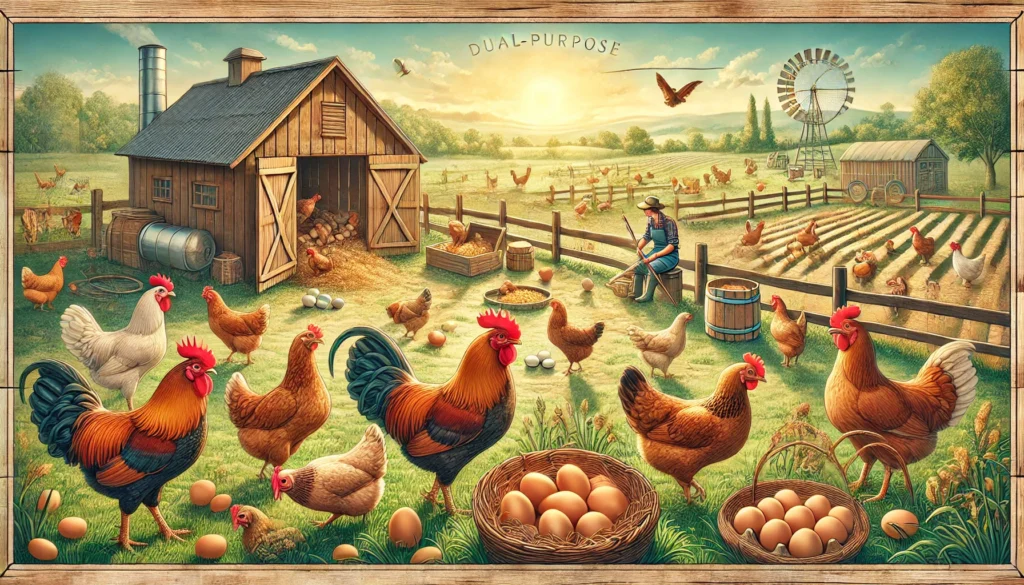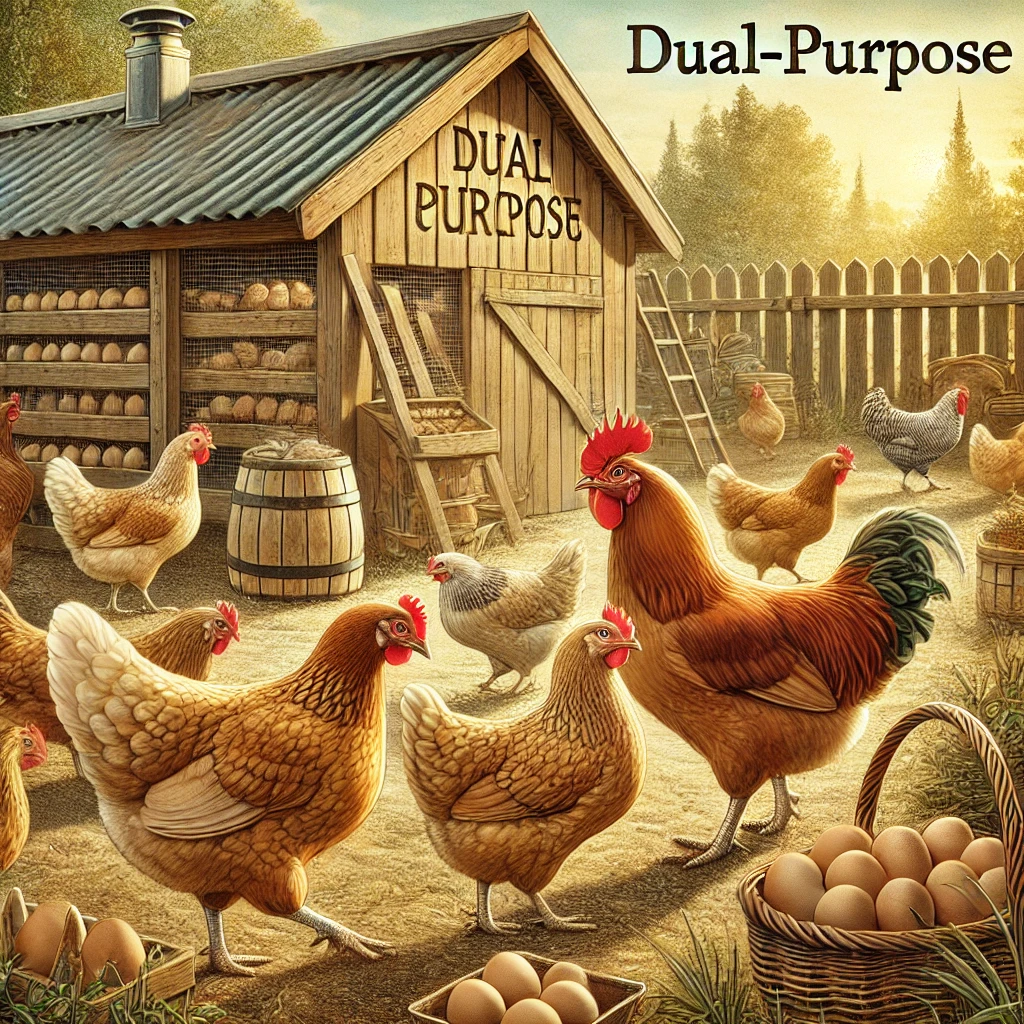In the world of poultry farming, the distinction between egg-laying and meat-producing chickens is often clear. However, dual-purpose chickens bridge the gap, offering farmers a breed that excels in both egg production and meat yield. These versatile birds have been a staple of small-scale farming for generations, prized for their adaptability, hardiness, and utility.
This article explores the history, characteristics, advantages, and challenges of raising dual-purpose chickens, as well as the top breeds to consider for your backyard or farm.
What Are Dual-Purpose Chickens?
Dual-purpose chickens are breeds specifically developed to provide both a reliable supply of eggs and a respectable meat yield. Unlike specialized layers or broilers, dual-purpose chickens offer a balanced approach, making them ideal for homesteaders, hobby farmers, and those looking for self-sufficiency.
Key Characteristics
- Moderate Egg Production: Typically, these breeds lay 200–280 eggs annually.
- Good Meat Quality: They grow larger than egg-laying breeds but may take longer to reach market weight compared to commercial broilers.
- Hardiness: Most dual-purpose breeds are robust and can thrive in various climates.
- Low Maintenance: They are well-suited to free-ranging systems and traditional farming practices.
The History of Dual-Purpose Chickens
Before the industrialization of agriculture, all chickens were essentially dual-purpose. Farmers relied on their flocks for both eggs and meat, selecting birds based on their ability to thrive in local conditions.
- Pre-Industrial Farming: Dual-purpose chickens were essential to rural households, providing eggs for daily consumption and meat for special occasions or winter storage.
- The Rise of Specialized Breeds: In the 20th century, poultry farming became more industrialized, leading to the development of highly specialized breeds like Leghorns for eggs and Cornish Cross for meat. This shift reduced the popularity of dual-purpose chickens in commercial operations but cemented their role in small-scale and backyard farming.
Benefits of Dual-Purpose Chickens
1. Versatility
Dual-purpose chickens eliminate the need to maintain separate flocks for eggs and meat, reducing costs and simplifying management.
2. Sustainability
These breeds are perfect for homesteaders and eco-conscious farmers looking to minimize waste. Hens can produce eggs for several years before being processed for meat.
3. Hardiness
Most dual-purpose breeds are sturdy, disease-resistant, and well-suited to free-ranging, making them ideal for diverse farming environments.
4. Flavorful Meat
While they may not grow as quickly as commercial broilers, dual-purpose chickens are renowned for their rich, flavorful meat.
5. Self-Sufficiency
For families or communities aiming for food independence, dual-purpose chickens provide a reliable source of both protein and sustenance.

Top Dual-Purpose Chicken Breeds
1. Rhode Island Red
- Egg Production: 250–300 eggs per year.
- Meat Quality: Tender, flavorful meat with a good yield.
- Traits: Hardy, adaptable, and easy to raise.
2. Plymouth Rock (Barred Rock)
- Egg Production: 200–280 eggs per year.
- Meat Quality: Large size with excellent flavor.
- Traits: Friendly and suitable for beginners.
3. Sussex
- Egg Production: 200–250 eggs per year.
- Meat Quality: Plump, juicy carcass.
- Traits: Docile and excellent foragers.
4. Orpington
- Egg Production: 175–200 eggs per year.
- Meat Quality: High-quality meat with good texture.
- Traits: Gentle and good for cold climates.
5. Wyandotte
- Egg Production: 200–240 eggs per year.
- Meat Quality: Medium-sized carcass with excellent flavor.
- Traits: Cold-hardy and aesthetically pleasing.
How to Raise Dual-Purpose Chickens
1. Housing
Provide a clean, secure coop with ample ventilation and nesting boxes for egg-laying. Ensure the coop is predator-proof.
2. Nutrition
- Feed a balanced diet that supports both egg production and healthy growth for meat.
- Allow free-ranging when possible to supplement their diet with insects and greens.
3. Breeding
Consider maintaining a rooster to allow for natural reproduction. This ensures a sustainable supply of chicks.
4. Health Management
- Monitor for signs of illness and provide vaccinations as necessary.
- Regularly clean their living space to prevent disease.
5. Harvesting Meat
Dual-purpose chickens typically take longer to mature than commercial broilers. Harvest them around 16–20 weeks for optimal meat quality.
Challenges of Dual-Purpose Chickens
While these breeds are highly versatile, they come with certain drawbacks:
1. Slower Growth
Compared to commercial broilers, dual-purpose chickens take longer to reach market weight, which may be a concern for farmers focused on efficiency.
2. Moderate Egg Production
Although they lay more eggs than meat breeds, their output is lower than specialized layers like Leghorns.
3. Economic Viability
In commercial settings, dual-purpose breeds are less profitable due to their moderate productivity. However, they remain a valuable choice for small-scale operations.
Why Choose Dual-Purpose Chickens?
For backyard farmers, homesteaders, and sustainable farming enthusiasts, dual-purpose chickens offer a practical and rewarding solution. Their ability to provide both eggs and meat ensures a steady food supply, while their hardiness and low maintenance make them an ideal choice for beginners and seasoned farmers alike.
Dual-Purpose Chickens in Sustainable Agriculture
As the world grapples with environmental challenges, dual-purpose chickens are increasingly recognized for their role in sustainable farming practices.
1. Biodiversity
Raising dual-purpose breeds helps preserve genetic diversity, which is critical for the resilience of poultry populations.
2. Reduced Resource Use
By eliminating the need for separate egg-laying and meat-producing flocks, farmers can reduce feed, water, and housing requirements.
3. Local Food Systems
Dual-purpose chickens are ideal for small-scale and local food systems, promoting food security and reducing reliance on industrial agriculture.
Popular Uses for Dual-Purpose Chickens
- Eggs: Fresh eggs for personal use or sale at local markets.
- Meat: High-quality, flavorful chicken for family meals or specialty markets.
- Breeding: Sustaining a self-replicating flock for long-term food production.
- Education: Teaching children and communities about sustainable farming practices.
Conclusion
Dual-purpose chickens are more than just versatile livestock; they are a testament to the ingenuity of traditional farming. By combining egg and meat production, these breeds offer a sustainable and efficient solution for those looking to embrace a self-sufficient lifestyle.
Whether you’re a backyard farmer, a homesteader, or simply someone who values high-quality, ethically raised poultry, dual-purpose chickens are an excellent choice. By raising these hardy, adaptable birds, you contribute to a farming legacy that values sustainability, resilience, and respect for the natural world.

